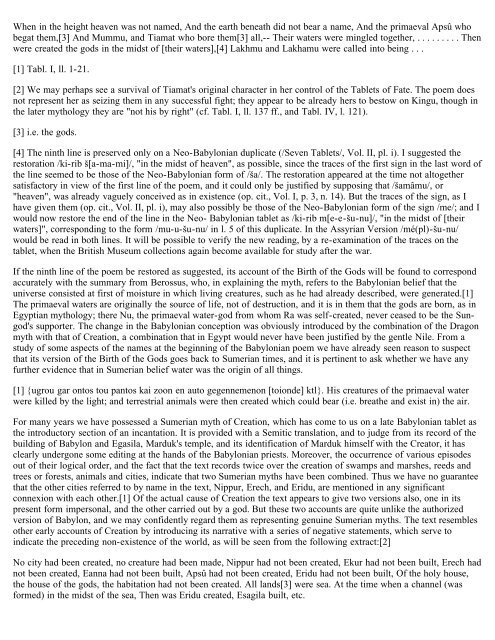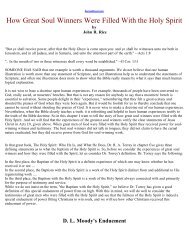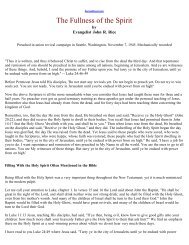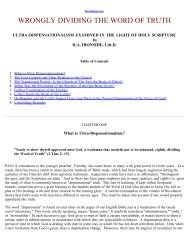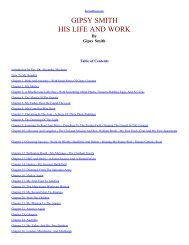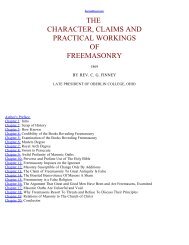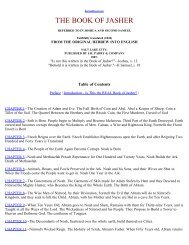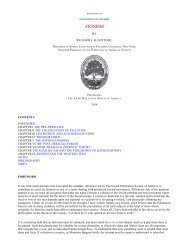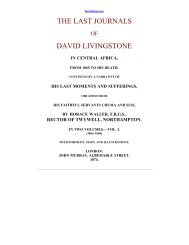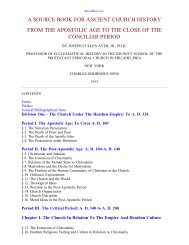Legends of Babylon and Egypt in Relation to Hebrew Tradition.pdf
Legends of Babylon and Egypt in Relation to Hebrew Tradition.pdf
Legends of Babylon and Egypt in Relation to Hebrew Tradition.pdf
You also want an ePaper? Increase the reach of your titles
YUMPU automatically turns print PDFs into web optimized ePapers that Google loves.
When <strong>in</strong> the height heaven was not named, And the earth beneath did not bear a name, And the primaeval Apsû who<br />
begat them,[3] And Mummu, <strong>and</strong> Tiamat who bore them[3] all,-- Their waters were m<strong>in</strong>gled <strong>to</strong>gether, . . . . . . . . . Then<br />
were created the gods <strong>in</strong> the midst <strong>of</strong> [their waters],[4] Lakhmu <strong>and</strong> Lakhamu were called <strong>in</strong><strong>to</strong> be<strong>in</strong>g . . .<br />
[1] Tabl. I, ll. 1-21.<br />
[2] We may perhaps see a survival <strong>of</strong> Tiamat's orig<strong>in</strong>al character <strong>in</strong> her control <strong>of</strong> the Tablets <strong>of</strong> Fate. The poem does<br />
not represent her as seiz<strong>in</strong>g them <strong>in</strong> any successful fight; they appear <strong>to</strong> be already hers <strong>to</strong> bes<strong>to</strong>w on K<strong>in</strong>gu, though <strong>in</strong><br />
the later mythology they are "not his by right" (cf. Tabl. I, ll. 137 ff., <strong>and</strong> Tabl. IV, l. 121).<br />
[3] i.e. the gods.<br />
[4] The n<strong>in</strong>th l<strong>in</strong>e is preserved only on a Neo-<strong>Babylon</strong>ian duplicate (/Seven Tablets/, Vol. II, pl. i). I suggested the<br />
res<strong>to</strong>ration /ki-rib š[a-ma-mi]/, "<strong>in</strong> the midst <strong>of</strong> heaven", as possible, s<strong>in</strong>ce the traces <strong>of</strong> the first sign <strong>in</strong> the last word <strong>of</strong><br />
the l<strong>in</strong>e seemed <strong>to</strong> be those <strong>of</strong> the Neo-<strong>Babylon</strong>ian form <strong>of</strong> /ša/. The res<strong>to</strong>ration appeared at the time not al<strong>to</strong>gether<br />
satisfac<strong>to</strong>ry <strong>in</strong> view <strong>of</strong> the first l<strong>in</strong>e <strong>of</strong> the poem, <strong>and</strong> it could only be justified by suppos<strong>in</strong>g that /šamâmu/, or<br />
"heaven", was already vaguely conceived as <strong>in</strong> existence (op. cit., Vol. I, p. 3, n. 14). But the traces <strong>of</strong> the sign, as I<br />
have given them (op. cit., Vol. II, pl. i), may also possibly be those <strong>of</strong> the Neo-<strong>Babylon</strong>ian form <strong>of</strong> the sign /me/; <strong>and</strong> I<br />
would now res<strong>to</strong>re the end <strong>of</strong> the l<strong>in</strong>e <strong>in</strong> the Neo- <strong>Babylon</strong>ian tablet as /ki-rib m[e-e-šu-nu]/, "<strong>in</strong> the midst <strong>of</strong> [their<br />
waters]", correspond<strong>in</strong>g <strong>to</strong> the form /mu-u-šu-nu/ <strong>in</strong> l. 5 <strong>of</strong> this duplicate. In the Assyrian Version /mé(pl)-šu-nu/<br />
would be read <strong>in</strong> both l<strong>in</strong>es. It will be possible <strong>to</strong> verify the new read<strong>in</strong>g, by a re-exam<strong>in</strong>ation <strong>of</strong> the traces on the<br />
tablet, when the British Museum collections aga<strong>in</strong> become available for study after the war.<br />
If the n<strong>in</strong>th l<strong>in</strong>e <strong>of</strong> the poem be res<strong>to</strong>red as suggested, its account <strong>of</strong> the Birth <strong>of</strong> the Gods will be found <strong>to</strong> correspond<br />
accurately with the summary from Berossus, who, <strong>in</strong> expla<strong>in</strong><strong>in</strong>g the myth, refers <strong>to</strong> the <strong>Babylon</strong>ian belief that the<br />
universe consisted at first <strong>of</strong> moisture <strong>in</strong> which liv<strong>in</strong>g creatures, such as he had already described, were generated.[1]<br />
The primaeval waters are orig<strong>in</strong>ally the source <strong>of</strong> life, not <strong>of</strong> destruction, <strong>and</strong> it is <strong>in</strong> them that the gods are born, as <strong>in</strong><br />
<strong>Egypt</strong>ian mythology; there Nu, the primaeval water-god from whom Ra was self-created, never ceased <strong>to</strong> be the Sungod's<br />
supporter. The change <strong>in</strong> the <strong>Babylon</strong>ian conception was obviously <strong>in</strong>troduced by the comb<strong>in</strong>ation <strong>of</strong> the Dragon<br />
myth with that <strong>of</strong> Creation, a comb<strong>in</strong>ation that <strong>in</strong> <strong>Egypt</strong> would never have been justified by the gentle Nile. From a<br />
study <strong>of</strong> some aspects <strong>of</strong> the names at the beg<strong>in</strong>n<strong>in</strong>g <strong>of</strong> the <strong>Babylon</strong>ian poem we have already seen reason <strong>to</strong> suspect<br />
that its version <strong>of</strong> the Birth <strong>of</strong> the Gods goes back <strong>to</strong> Sumerian times, <strong>and</strong> it is pert<strong>in</strong>ent <strong>to</strong> ask whether we have any<br />
further evidence that <strong>in</strong> Sumerian belief water was the orig<strong>in</strong> <strong>of</strong> all th<strong>in</strong>gs.<br />
[1] {ugrou gar on<strong>to</strong>s <strong>to</strong>u pan<strong>to</strong>s kai zoon en au<strong>to</strong> gegennemenon [<strong>to</strong>ionde] ktl}. His creatures <strong>of</strong> the primaeval water<br />
were killed by the light; <strong>and</strong> terrestrial animals were then created which could bear (i.e. breathe <strong>and</strong> exist <strong>in</strong>) the air.<br />
For many years we have possessed a Sumerian myth <strong>of</strong> Creation, which has come <strong>to</strong> us on a late <strong>Babylon</strong>ian tablet as<br />
the <strong>in</strong>troduc<strong>to</strong>ry section <strong>of</strong> an <strong>in</strong>cantation. It is provided with a Semitic translation, <strong>and</strong> <strong>to</strong> judge from its record <strong>of</strong> the<br />
build<strong>in</strong>g <strong>of</strong> <strong>Babylon</strong> <strong>and</strong> Egasila, Marduk's temple, <strong>and</strong> its identification <strong>of</strong> Marduk himself with the Crea<strong>to</strong>r, it has<br />
clearly undergone some edit<strong>in</strong>g at the h<strong>and</strong>s <strong>of</strong> the <strong>Babylon</strong>ian priests. Moreover, the occurrence <strong>of</strong> various episodes<br />
out <strong>of</strong> their logical order, <strong>and</strong> the fact that the text records twice over the creation <strong>of</strong> swamps <strong>and</strong> marshes, reeds <strong>and</strong><br />
trees or forests, animals <strong>and</strong> cities, <strong>in</strong>dicate that two Sumerian myths have been comb<strong>in</strong>ed. Thus we have no guarantee<br />
that the other cities referred <strong>to</strong> by name <strong>in</strong> the text, Nippur, Erech, <strong>and</strong> Eridu, are mentioned <strong>in</strong> any significant<br />
connexion with each other.[1] Of the actual cause <strong>of</strong> Creation the text appears <strong>to</strong> give two versions also, one <strong>in</strong> its<br />
present form impersonal, <strong>and</strong> the other carried out by a god. But these two accounts are quite unlike the authorized<br />
version <strong>of</strong> <strong>Babylon</strong>, <strong>and</strong> we may confidently regard them as represent<strong>in</strong>g genu<strong>in</strong>e Sumerian myths. The text resembles<br />
other early accounts <strong>of</strong> Creation by <strong>in</strong>troduc<strong>in</strong>g its narrative with a series <strong>of</strong> negative statements, which serve <strong>to</strong><br />
<strong>in</strong>dicate the preced<strong>in</strong>g non-existence <strong>of</strong> the world, as will be seen from the follow<strong>in</strong>g extract:[2]<br />
No city had been created, no creature had been made, Nippur had not been created, Ekur had not been built, Erech had<br />
not been created, Eanna had not been built, Apsû had not been created, Eridu had not been built, Of the holy house,<br />
the house <strong>of</strong> the gods, the habitation had not been created. All l<strong>and</strong>s[3] were sea. At the time when a channel (was<br />
formed) <strong>in</strong> the midst <strong>of</strong> the sea, Then was Eridu created, Esagila built, etc.


